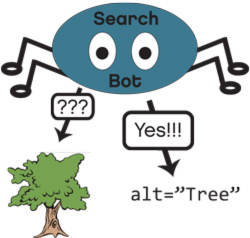Alt Tags - SEO - Accessibility
Search Engine Bots and visually impaired visitors don't see images. Alternative Text, or Alt Tags, provide bots, auditory browsers, and visual impaired people with a verbal description of graphic elements.
Alt Tags and ADA Compliance
Alt Tags enable visually impaired visitors using auditory browsers to access information. Without relevant Alt Tags, your website may not be ADA Section 508 compliant (or WAI compliant in Europe), and could pose a potential liability problem.
Alt Tags and Image Search
A tree farm website probably has multiple tree photos: Potential clients might search for a tree type. Photos on the page don't communicate with Search Engine Bots. Alt Tags, with content like "blue spruce pine tree" could help the page to be indexed for trees, pines, spruce, blue spruce and other probable search keywords of people looking to buy trees.
Even if you have the information elsewhere on the page, using Alt Tags will reinforce that the page is about that subject matter.

Alternative Text Attribute
Technically, the "Alt Tag" should be called "Alternative Text Attribute (It is an Attribute because it modifies the underlying image)." However, they are commonly called "Alt Tags." Images cannot not validate in the W3C validator without an Alt Tag.

Without Alt Tags, a website does not comply to validation standards. Many web developers get lazy and simply insert an empty Alt Tag, which does comply, but hurts search rankings and isn't helpful to visually impaired visitors.